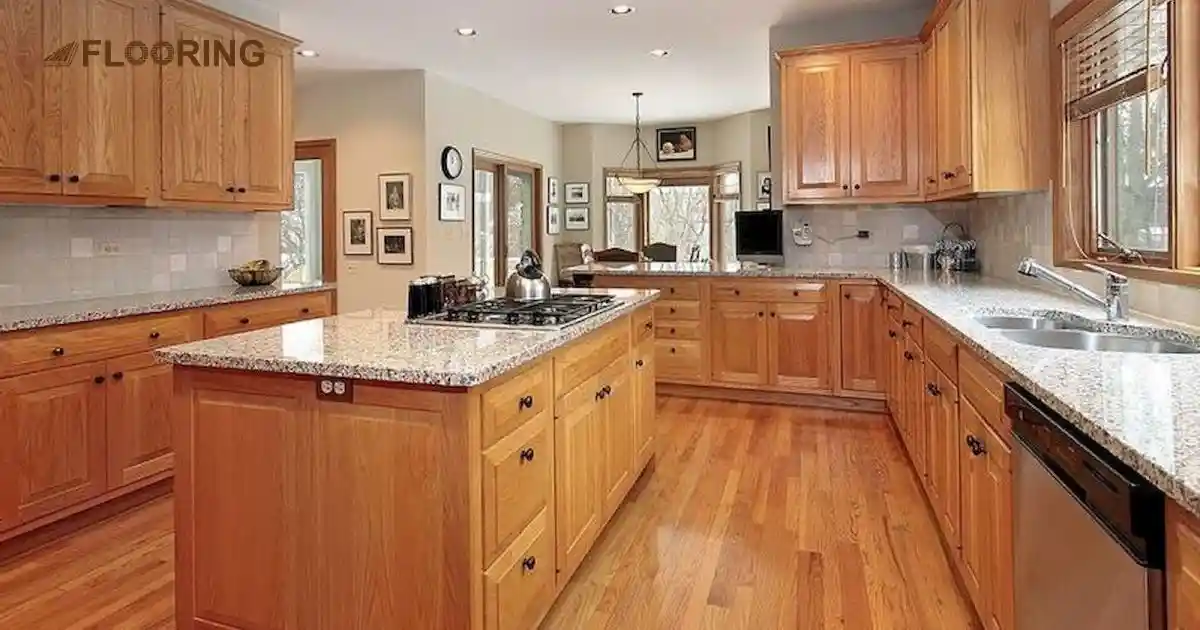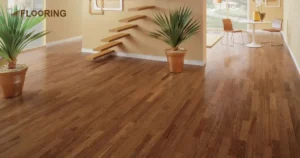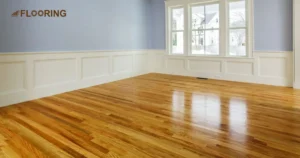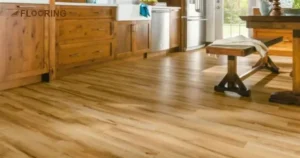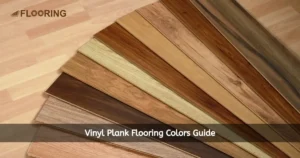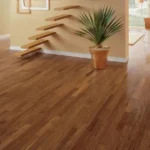Struggling to find the perfect match between your wood floors and wood cabinets? Coordinating wood floors with wood cabinets can be challenging, but when done right, it transforms your home into a warm and cohesive space. It’s not just about choosing the right shades; it’s about creating a seamless flow that draws the eye and leaves a lasting impression.
Now, it’s time to explore practical ways to achieve this harmony in your home. Whether you’re dealing with a wood floor with dark cabinets or lighter tones, this article will ensure that your space looks both stylish and cohesive. Let’s explore how to bring your vision to life with the right wood combinations.
📑 Table of Content
Key Takeaways
Match Undertones: Ensure that the undertones of wood cabinets on wood floors match for a harmonious look.
Balance Contrast: Use contrast wisely to create visual interest while maintaining a cohesive design.
Consider Lighting: Lighting plays a crucial role in how wood floors with wood cabinets appear in your space.
Install Floors Last: Installing hardwood floors with wood cabinets after the cabinets prevents damage and allows for easy updates.
Utilize Natural Light: Natural light enhances the true color of the wood, adding warmth to the room.
Choose Appropriate Finishes: Matching or complementary finishes can unify the look of your wood floor and wood kitchen cabinets.
Why Coordinating Wood Floors With Wood Cabinets Matter?
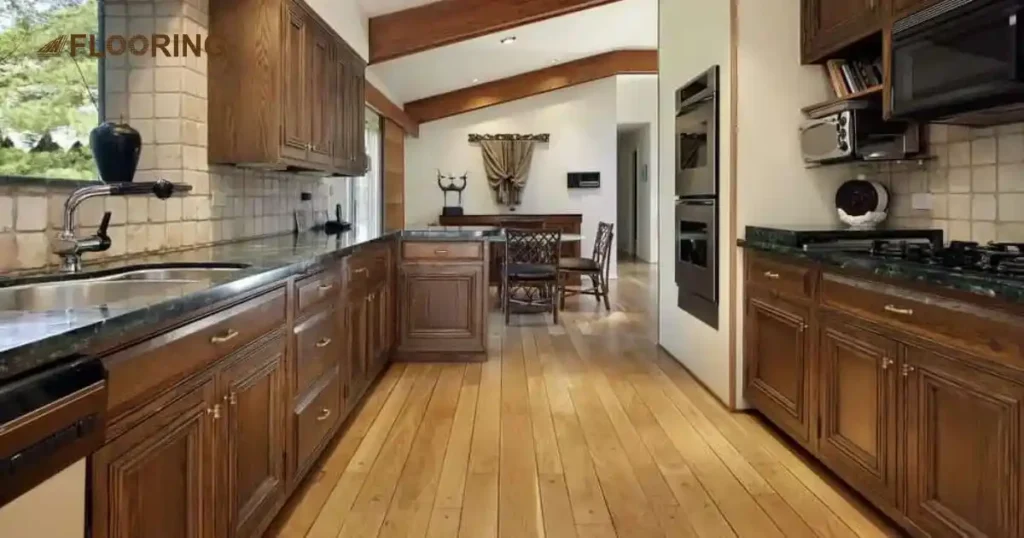
Coordinating wood floors with wood cabinets is more than just a design choice, it’s essential for creating a unified and visually appealing space. When these elements are properly matched, they enhance the overall aesthetic, making the room feel warm, inviting, and well-balanced.
On the other hand, mismatched wood tones or grains can disrupt the flow of a room, making it feel disjointed or chaotic. By thoughtfully pairing wood floors and wood cabinets, you ensure that every aspect of your design works together to create a seamless look that reflects your personal style.
Coordinating Wood Floors With Wood Cabinets in Open Spaces
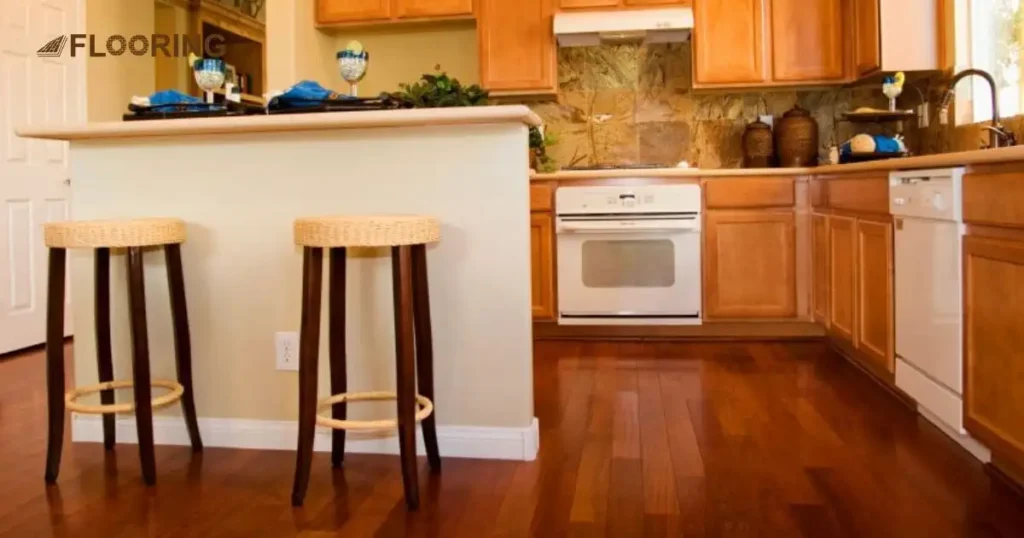
Open spaces present a unique challenge when it comes to coordinating wood floors with wood cabinets. The large, continuous areas mean that every element must work together to maintain a cohesive look. While you have more freedom to play with different wood finishes, it’s crucial to ensure that these variations contribute to a unified design rather than clash.
Defining Zones with Different Wood Finishes
In open spaces, defining zones with different wood finishes can help create distinct areas while maintaining a cohesive look. For instance, you might use a lighter wood floor in the kitchen to make it feel more open and airy, while a darker wood finish in the living area adds warmth and coziness.
The key is to choose wood tones that complement each other, ensuring a smooth transition between the zones. By strategically using different finishes, you can break up the monotony without disrupting the harmony between wood floors and wood cabinets.
Maintaining a Cohesive Look Across Large Areas
Maintaining a cohesive look across large areas is crucial in open spaces. The continuity of wood tones and grains ensures that the space feels unified rather than fragmented. When coordinating wood floors with wood cabinets in expansive areas, it’s essential to keep the wood tones consistent or within the same color family.
This approach creates visual flow and prevents the space from feeling disjointed. Additionally, consider using similar finishes on both the floors and cabinets to reinforce this cohesive look, allowing the natural beauty of the wood to shine through.
Best Wood Combinations for Modern Kitchens
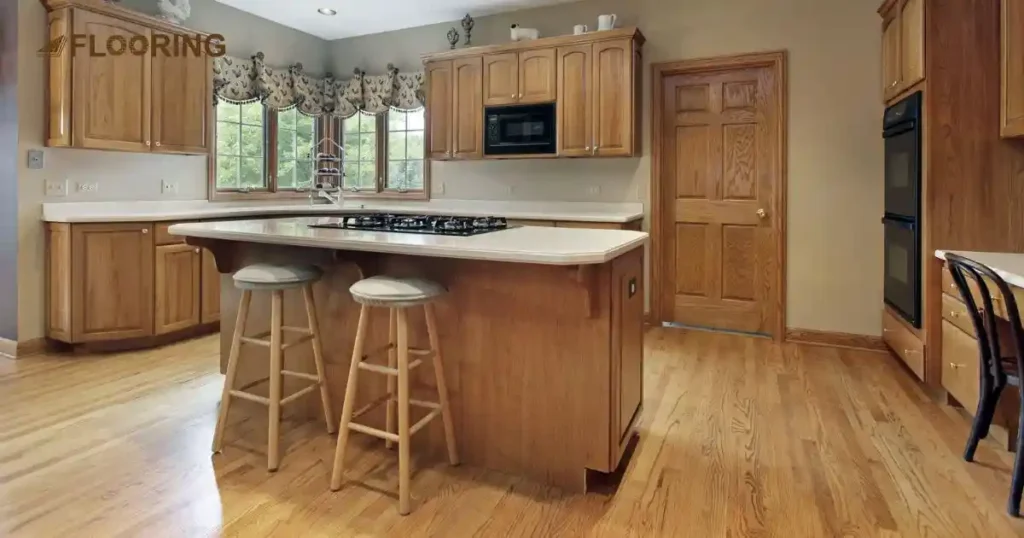
Modern kitchens often favor a sleek, minimalist look, making the choice of wood combinations critical.
- Light wood cabinets paired with darker wood floors can create a striking contrast that adds depth and interest to the space.
- Pairing light wood floors with medium-toned wood cabinets can maintain a clean, airy feel, ideal for smaller or more contemporary kitchens.
The best wood combinations will depend on the overall aesthetic you’re aiming for, but balance is key. For a cohesive look, ensure that the wood floors with wood cabinets share similar undertones, even if the shades differ. This subtle connection will tie the elements together, making your kitchen feel both modern and inviting.
How to Mix Wood Cabinets with Wood Floors in Small Kitchens?
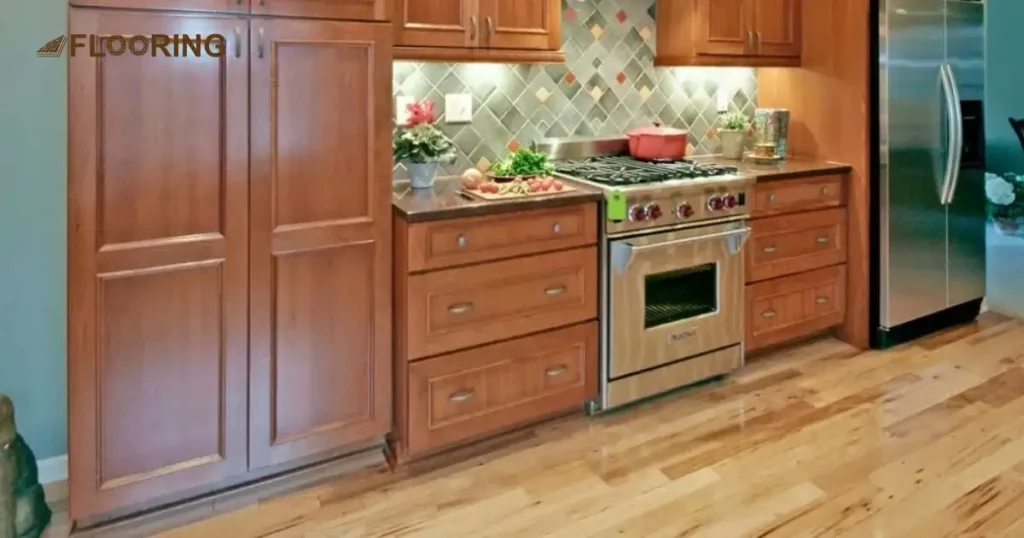
In small kitchens, the right combination of wood cabinets and wood floors can make all the difference in how spacious and open the area feels. While it’s tempting to use bold, contrasting woods, sticking to lighter tones will help prevent the space from feeling cramped. By thoughtfully mixing wood elements, you can create a kitchen that feels larger and more cohesive.
Creating the Illusion of Space
Creating the illusion of space in a small kitchen often comes down to your choice of wood tones. Light wood floors paired with matching cabinets can reflect more light, making the area feel more expansive.
Using wood with minimal grain patterns can also help keep the design simple and uncluttered. By choosing the right wood combinations, you can open up your kitchen and make it feel more inviting, despite its size.
Using Light Wood Tones to Brighten Up the Area
Using light wood tones in a small kitchen is a proven strategy to brighten up the area. Light wood floors and cabinets reflect natural light, giving the space a more open and airy feel. This approach not only enhances the sense of space but also creates a warm and welcoming atmosphere.
The Role of Lighting in Coordinating Wood Floors and Cabinets
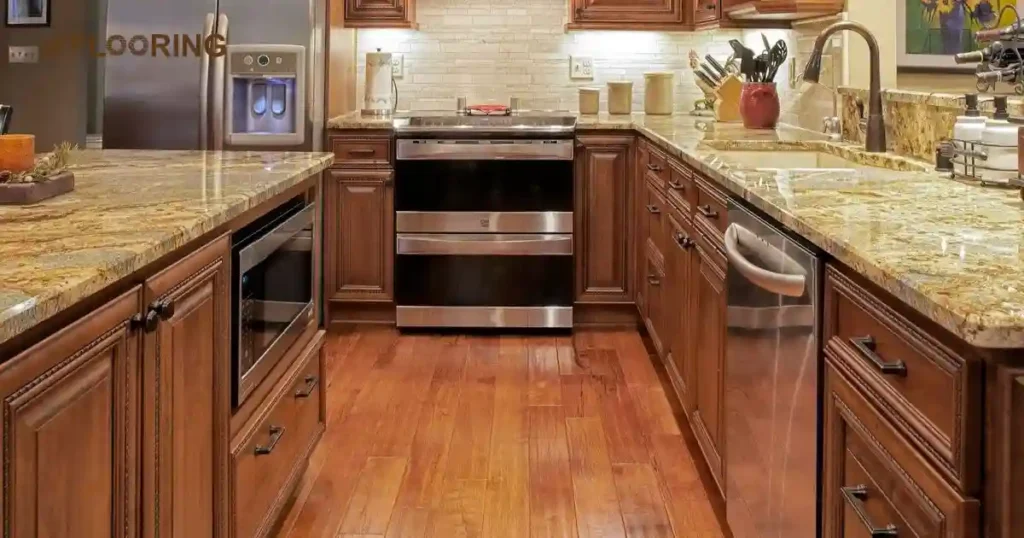
Lighting plays a crucial role in how wood floors and wood cabinets appear in a space. The way light interacts with the wood’s texture and color can enhance or diminish the overall look of your kitchen. Proper lighting ensures that both the floor and cabinets look their best, highlighting the natural beauty of the wood while creating a warm, inviting atmosphere.
Natural vs Artificial Lighting
The way natural and artificial lighting affects wood floors and cabinets can dramatically change the ambiance of a room. The table below compares the impact of these two types of lighting on wood finishes:
| Natural Lighting | Artificial Lighting |
| Enhances natural wood grain and color | Can create warmer or cooler tones |
| Changes throughout the day | Consistent light at all times |
| Best for showing true wood color | Can be adjusted with different bulbs |
| Makes spaces feel larger and more open | Often highlights specific areas |
| Can cause wood to fade over time | Does not fade wood |
| Works well with light wood tones | Better for controlling the ambiance |
| Varies with weather and season | Reliable, controllable source of light |
| Adds natural warmth to the room | Can be harsh if not properly diffused |
Understanding how natural and artificial lighting influences wood is essential for making the best design choices. Balancing these two types of lighting can help you achieve the perfect look for your kitchen with wood cabinets and wood floors.
Using Lighting to Enhance the Tones of Wood Cabinets On Wood Floors
Using lighting strategically can significantly enhance the wood tones in your kitchen. Warm lighting, such as soft white or amber bulbs, can deepen the richness of darker wood floors and cabinets, making the space feel cozy and inviting.
On the other hand, cooler lighting can brighten up lighter wood tones, giving the room a fresh, airy feel. To make the most of your wood floor and wood cabinets, consider using a mix of overhead lighting, under-cabinet lights, and accent lights.
Transform Your Kitchen with Matching Wood Floors and Cabinets
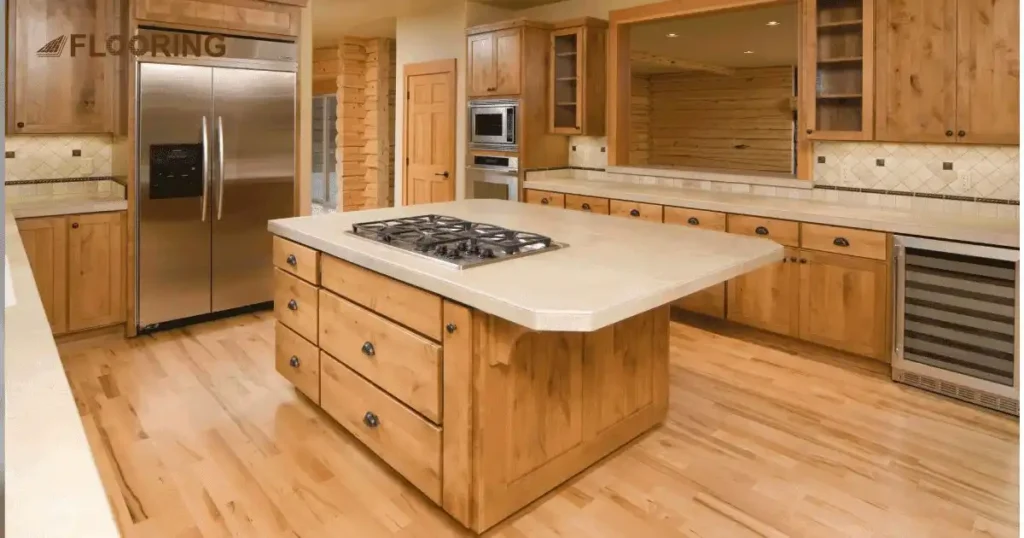
Matching wood floors with wood cabinets can completely transform your kitchen, creating a seamless and cohesive look. When the wood tones and finishes complement each other, the kitchen feels more unified and sophisticated.
This approach can also make your kitchen appear more spacious, as the continuous wood tones draw the eye smoothly across the room. Whether you prefer light, airy woods or rich, dark tones, ensuring that your floors and cabinets are in harmony will elevate the overall design.
By carefully selecting wood types that work well together, you can create a kitchen that not only looks beautiful but also feels warm and inviting, making it the heart of your home.
10 Best Tips for Coordinating Wood Floors With Wood Cabinets
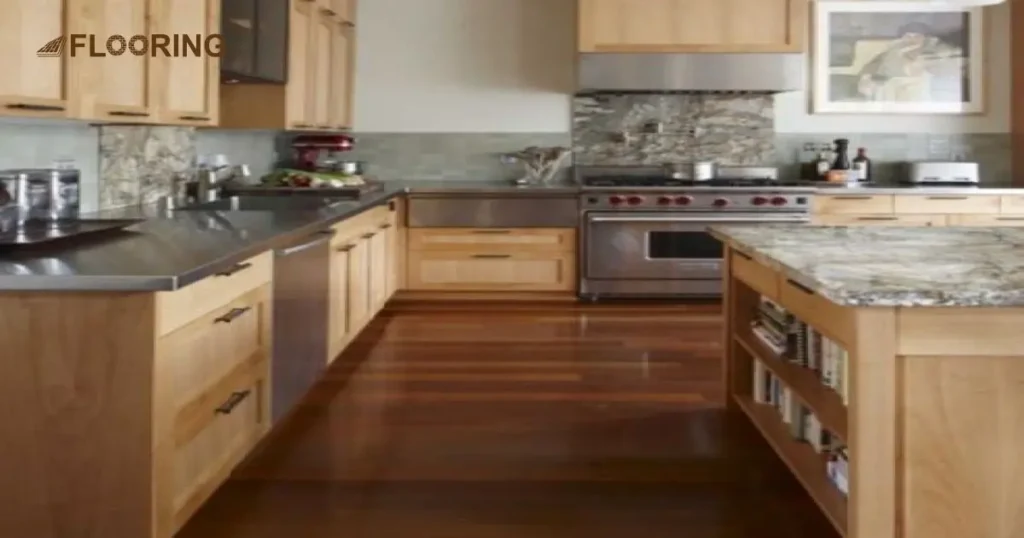
Coordinating wood floors with wood cabinets can be tricky, but these tips will help you achieve a balanced and stylish look:
- Consider Undertones: Ensure that the wood undertones match or complement wood cabinets on wood floors.
- Use Contrast Wisely: Pair dark cabinets with light floors or vice versa for visual interest.
- Match Grain Patterns: Similar grain patterns can create a more cohesive design.
- Test Samples: Always test wood samples together in your kitchen’s lighting before making a final decision.
- Think About Finish: Matching or complementary finishes can unify the look.
- Balance Warm and Cool Tones: Don’t mix warm and cool tones unless done deliberately for contrast.
- Layer with Rugs: Rugs can help break up large areas of wood and add texture.
- Use Neutral Colors: Neutral walls and countertops can help balance bold wood choices.
- Consider the Room Size: Light wood can make a small room feel bigger like a laundry room, while dark wood can add warmth to a large space.
- Consult a Professional: If unsure, a designer can help you make the right choice.
By following these tips, you can ensure that your wood cabinets and wood floors work together beautifully, enhancing the overall aesthetic of your kitchen.
Top 5 Mistakes to Avoid When Coordinating Wood Floor and Cabinets
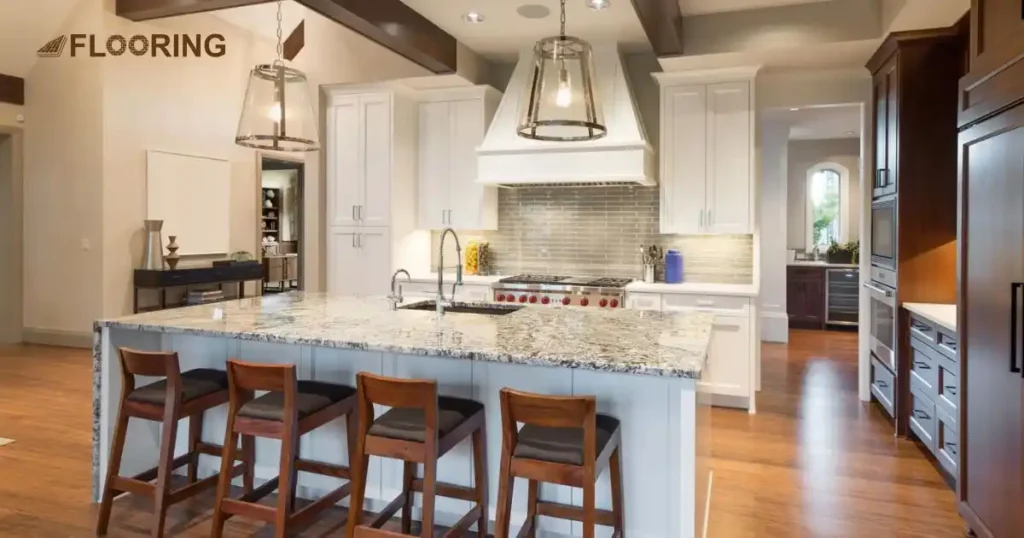
Coordinating wood floors and wood cabinets requires careful planning. Avoid these common mistakes to ensure your kitchen looks its best:
Ignoring Undertones
Mismatched undertones can make the space feel disjointed. Always consider the undertones of both the floor and cabinets to ensure they complement each other. For instance, pairing warm-toned wood floors with cool-toned wood cabinets can create a clash that disrupts the harmony of the room.
Over-Matching Wood Cabinets Wood Floor
While coordination is key, too much matching can make the space look flat. A bit of contrast, whether in the shade or finish, can add depth and interest. For example, pairing a light wood floor with slightly darker wood cabinets creates a visually appealing contrast without being overwhelming.
Neglecting Lighting
Lighting plays a significant role in how the wood tones appear. Failing to consider how natural and artificial lighting affects your wood choices can result in an unappealing look. Proper lighting can enhance the richness of the wood, while poor lighting can make it look dull.
Skipping Samples
Always test wood samples in your actual space. What looks good in the store might not work in your kitchen’s lighting and environment. By testing samples, you can see how the wood floors and cabinets will look together and make adjustments before making a final decision.
Overlooking Room Size
The size of your kitchen should influence your wood choices. Dark wood can make a small space feel even smaller, while light wood can help open up a larger area. Tailoring your wood selections to the size of your kitchen ensures a balanced and comfortable space.
Frequently Asked Questions
Can you have wood floors and wood cabinets?
Yes, you can have wood floors and wood cabinets together. When done right, they can create a warm, cohesive look that enhances the overall design of your space.
How do you coordinate wood cabinets with wood floors?
To coordinate wood cabinets with wood floors, match the undertones and consider the contrast between the two. This balance ensures a harmonious design that feels well thought out.
What flooring goes best with wood cabinets?
Wood floors with wood cabinets work best when the tones either match or contrast in a complementary way. Light wood floors with dark cabinets or vice versa often create the most balanced look.
What kitchen cabinets go well with wood floors?
In a kitchen with wood floors and wood cabinets, opt for cabinets that either match or contrast with the flooring. This creates visual interest and helps define different areas of the space.
How to pick wood floors with wood cabinets?
When picking wood floors with wood cabinets, consider the overall color scheme and lighting. Testing samples in your kitchen will help you make the best choice.
Should you install hardwood floors before or after cabinets?
It’s generally better to install hardwood floors with wood cabinets after the cabinets. This approach helps avoid damage during cabinet installation and allows for easy future changes.
Conclusion
Coordinating wood floors with wood cabinets is an art that brings a room together, creating a unified and elegant look. When you carefully select matching or complementary wood tones, the result is a space that feels cohesive, warm, and inviting. You know, wood has benefits beyond aesthetics, such as durability and natural beauty, making it a wise choice for any kitchen.
Taking the time to coordinate wood floors with wood cabinets not only enhances your kitchen’s appearance but also adds value to your home. Coordinating wood floors with wood cabinets transforms your kitchen into a beautiful and functional space that truly feels like the heart of your home.
